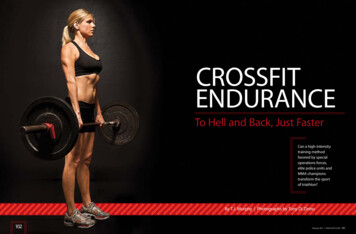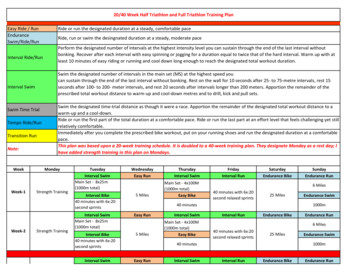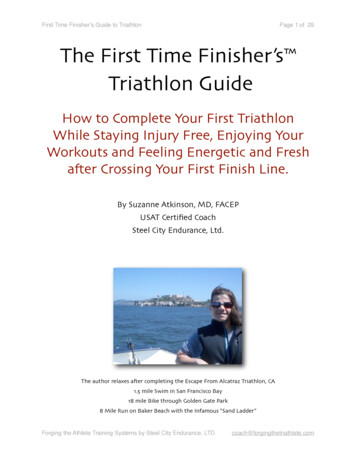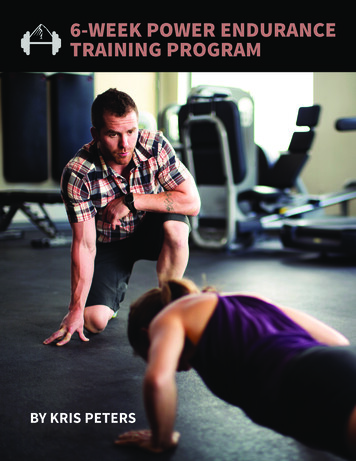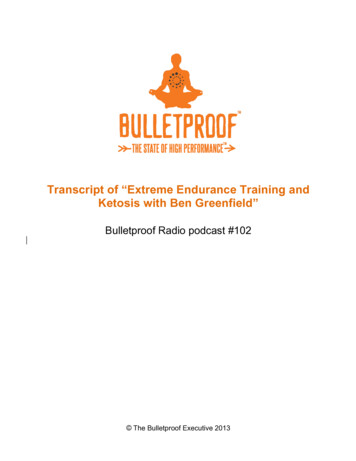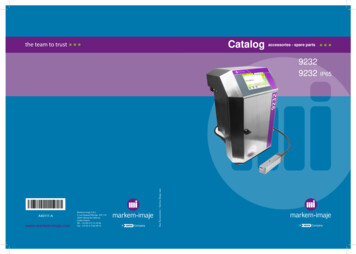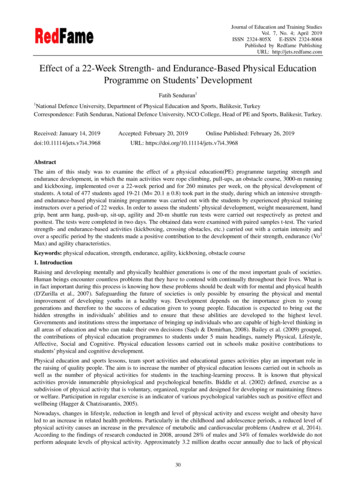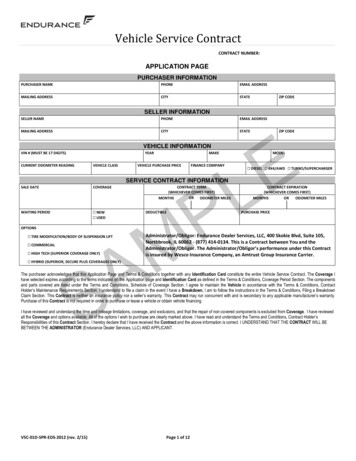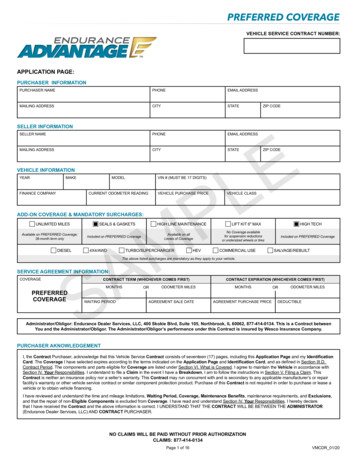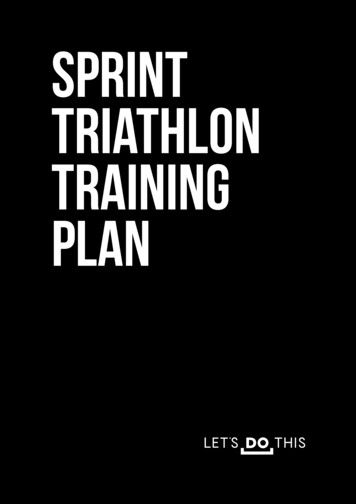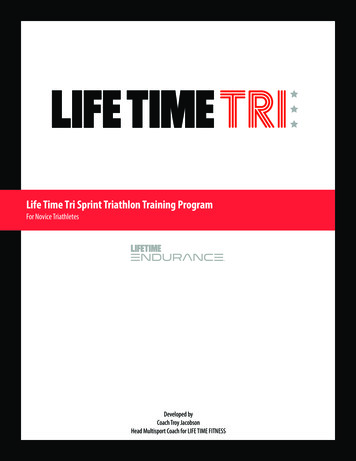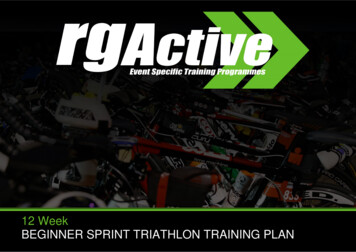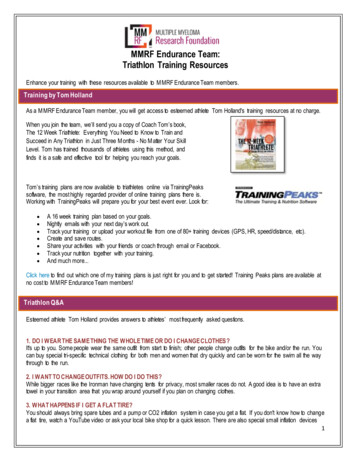
Transcription
MMRF Endurance Team:Triathlon Training ResourcesEnhance your training with these resources available to M MRF Endurance Team members.Training by Tom HollandAs a M MRF Endurance Team member, you will get access to esteemed athlete Tom Holland's training resources at no charge.When you join the team, we‘ll send you a copy of Coach Tom‘s book,The 12 Week Triathlete: Everything You Need to Know to Train andSucceed in Any Triathlon in Just Three M onths - No M atter Your SkillLevel. Tom has trained thousands of athletes using this method, andfinds it is a safe and effective tool for helping you reach your goals.Tom‘s training plans are now available to triathletes online via TrainingPeakssoftware, the most highly regarded provider of online training plans there is.Working with TrainingPeaks will prepare you for your best event ever. Look for: A 16 week training plan based on your goals.Nightly emails with your next day‘s work out.Track your training or upload your workout file from one of 80 training devices (GPS, HR, speed/distance, etc).Create and save routes.Share your activities with your friends or coach through email or Facebook.Track your nutrition together with your training.And much more.Click here to find out which one of my training plans is just right for you and to get started! Training Peaks plans are available atno cost to M M RF Endurance Team members!Triathlon Q&AEsteemed athlete Tom Holland provides answers to athletes‘ most frequently asked questions.1. DO I WEAR THE SAME THING THE WHOLE TIME OR DO I CHANGE CLOTHES?It's up to you. Some people wear the same outfit from start to finish; other people change outfits for the bike and/or the run. Youcan buy special tri-specific technical clothing for both men and women that dry quickly and can be worn for the swim all the waythrough to the run.2. I WANT TO CHANGE OUTFITS. HOW DO I DO THIS?While bigger races like the Ironman have changing tents for privacy, most smaller races do not. A good idea is to have an extratowel in your transition area that you wrap around yourself if you plan on changing clothes.3. WHAT HAPPENS IF I GET A FLAT TIRE?You should always bring spare tubes and a pump or CO2 inflation system in case you get a flat. If you don't know how to changea flat tire, watch a YouTube video or ask your local bike shop for a quick lesson. There are also special small inflation devices1
you can purchase that allow you to blow up and patch the tire without having to change the tube. Chances are you won't get aflat, but you want to be prepared just in case bad luck strikes.4. DO I NEED A WETSUIT?Wetsuits help keep you warm while also increasing your buoyancy, which makes you a more efficient swimmer. Unless thewater is too warm for a wetsuit (you can overheat if you wear one when the water temp is around 80 degrees or more) mostpeople choose to wear one given the benefits.5. DO I NEED TO BUY A SPECIAL "TRI BIKE”?I rented a bike for my first few triathlons. It depends on the race distance and your goals, but you can do it on a mountain bike,hybrid, road, bike, whatever.6. I WANT TO BUY A NEW BIKE FOR MY RACE. HOW MUCH SHOULD I SPEND?You could spend anywhere from 500 to 15,000 or more on a bike if you wanted to. You can however, buy a perfectly goodentry-level bike for 1000- 2000.7. WHAT SHOULD I EAT BEFORE A RACE?If you are doing a sprint or Olympic-distance tri then there is no reason to add in additional calories before the race. Simply eatwhat you would normally have before a bigger workout. If you are doing a half or full Ironman triathlon, then you will want to starttaking in additional carbohydrates starting 2-3 days before your race.8. I AM NERVOUS ABOUT THE SWIM.Of all three legs of the triathlon, it is the swim that stresses people out the most. Two things you can do to help alleviate this:One, after the gun goes off, count to ten before getting in the water to let the faster swimmers get ahead of you, and two, starton the outside of the pack rather than the inside. You may swim a slightly longer distance but you will avoid the trashing thatgoes on inside the "swim scrum."9. WHERE DO I PUT ALL MY RACE GEAR DURING THE RACE?At most races you will have a transition area consisting of rows and rows of bike racks. You will "rack" your bike on the spot withyour corresponding race number, then lay out all of your gear next to your bike. Sneakers, clothing, nutrition, everything you willbe using during the event. I recommend bringing a small towel and laying it on the ground to mark your spot, then put all yourgear on top of it.10. WHAT GEAR DO I ABSOLUTELY NEED TO DO THE TRI?Five things: A race outfit, swim goggles, bike, bike helmet and running sneakers. Everything else is extra.11. I HAVE MORE QUESTIONS!Read my book The 12-Week Triathlete. It is filled with the answers to all your tri questions. I have raced every distance onalmost every continent and I have made all the mistakes so you don't have to!Marathon and Half Marathon Q&ATom Holland, acclaimed lifestyle and fitness expert, has partnered with the M M RF Endurance Team to share his proven tips fortraining for a triathlon. The shared goal? To enable you to make your next race your best, both physically and mentally.WEEK #1 – Get Your Training Plain in PlaceThere are many different training plans you can follow. In fact, if you do a little research, you can become overwhelmed. Irecommend that you find one that makes sense for you from a reputable source and then stick with that. I outline numerousdifferent plans in both the first and second editions of my book The 12-Week Triathlete, and you can also find free training planson the Internet. The key is to find a plan to follow that fits your goals, your fitness level and your available time to train.2
When you joined the team, you were sent a copy of my book, Tom Holland's The 12-Week-Triathlete: Everything You Needto Know to Train and Succeed in Any Triathlon in Just Three Months – No Matter Your Skill Level. Thousands of peoplearound the world have completed triathlons using my plans, from the sprint distance all the way up to the Ironman. It doesn'tmatter whether you are a complete beginner or seasoned veteran; these plans can help you have your best race whileremaining injury-free.I have also created plans for both the Olympic and Ironman distance triathlons and made them available on an interactive basis,via TrainingPeaks software, the most highly regarded provider of online training plans there is. Working with TrainingPeaks willprepare you for your best event ever: Look for nightly emails with your next day's workout.Track your training or upload your workout file from one of 80 training devices (GPS, HR, speed/distance, etc).Create and save routes.Share your activities with your friends or coach through email or Facebook.Track your nutrition together with your training.(And much more.)So, if you like what you see in my book, and want to receive the same plans and motivational training advice built into an onlinetraining log and plan, sign up to receive my triathlon training plan via TrainingPeaks.Click here to find out which one of my training plans is just right for you. These plans are available to M MRF Endurance Teammembers at no cost. Simply enter code "mmrf" in the PROM O/COUPON box when you check out!WEEK #2 – Set Goals and Keep a LogSet Goals: I believe that the primary goal for first-time triathletes should be to just get to that finish line. Setting a realistic timegoal is extremely difficult to do with no prior history as a comparison, and this type of goal can add a great deal of unnecessarystress to both your training and on race day. Just finishing a triathlon is a huge accomplishment! M y goal as a coach with myclients is three-fold; first, to get them to the starting line healthy; second, to adequately prepare them for the race so they havean enjoyable experience, and third, to make sure that they enjoy the training process and the race enough that they want to do itagain. You should strive for the same results for yourself.If this is not your first triathlon and you wish to improve your time from a previous race, be sure not to be too aggressive withyour new time goal. Remember that certain elements are out of your control including the layout of the course and the weather.Both of these can drastically affect your performance.Regardless of the number of triathlons you have competed in, make finishing your primary goal. Choose a specific time as yoursecondary goal. If you wake up on race morning and it is 90 degrees and ridiculously humid outside, it's a very smart idea todrop the time goal and just enjoy the race! Even though I have completed dozens of tri‘s including 20 Ironmans myself, myprimary goal is still first and foremost to make it to that finish line, period.Keep a log: One of the simplest things you can do to ensure major success in your training is to keep a training log. Jottingdown a few short notes after each workout will:1. Help you avoid injury by illuminating those elements of your training that may cause pain (increasing mileage tooquickly, incorrectly changing footwear, running on a certain surface, etc.)2. Help you ‗dial in‘ your personal nutrition and hydration strategy by keeping notes on what you consume prerun/ride/swim, during your workout and post workout, so you can learn what works best for you.3. Let you know when it's time for a new pair of shoes, a bike tune-up, etc.4. Help you determine the best clothing and gear for you.3
5. Serve as a huge confidence boost during the taper, your final weeks of training, when you can look over your log toremind yourself of all the hard work you have put in and how prepared you are!The log need not be time consuming. Just write down a few basic notes on the details of each training session. You can use anotebook or your computer, a calendar, the log on TrainingPeaks – whatever works best for you. Not only will this log help youimmeasurably for this triathlon, it will prove to be an invaluable resource for all of your future races as well!WEEK #3 – Building Volume for Injury-Free TrainingOne of the most important aspects of triathlon training is building your training volume, the amount you train each week, wisely.M any triathlon-related injuries are directly caused by doing "too much too soon," increasing your swim/bike/run volume toorapidly. Shin splints and knee pain are two common ailments that can arise from building your running mileage incorrectly.Shoulder pain is common in swimming too much, too soon. The good news is that by gradually increasing your training volumeand "periodizing" your training, you can get to race-day injury-free.In layman's terms, periodization simply means "cycling" your training, gradually increasing and then decreasing your totaltraining volume over time. For triathletes this translates into 3 or 4 week cycles consisting of adding a little more training time ineach week, followed by a "recovery" week where you decrease the training time to allow your body to "absorb" what you havedone and prepare it for the additional volume to come. One mistake I have seen in so many athletes over the years is the lack ofthese recovery weeks in their training. Scheduled recovery weeks are essential to your triathlon success and cannot be left outof your program.A few rules to remember when building training volume:1. Don't increase your training time too drastically from one week to the next.2. Don't "cram" missed workouts in and throw off your overall plan.3. Work on your weakness! M ost triathletes excel in one of the three sports. Don't make the mistake of consistentlymissing the workout that you least enjoy. If swimming is your weakest discipline, focus on getting those workouts in firstand foremost. On race day you will be very glad you did!4. Stick to YOUR plan. Don't worry about what others may be doing; stay focused on your own program.5. Be sure to help your body adapt positively to the increased mileage by strength-training, stretching, resting and eating ahealthy diet.WEEK #4 – Join a Training GroupNothing makes your triathlon training more enjoyable and easier than joining a training group. Sure, we are all busy, but you areabout to spend a lot of time swimming, cycling and running. Joining a group helps you find others who are at your same traininglevel, and will provide you with like-minded athletes to work out with you as go through the many weeks leading up to race day.It‘s easy to find a group. Go online to www.TriFind.com. You will be amazed how organized and welcoming triathlon clubs are.There are probably several in your community. M ost have athletes of all levels, so you will not only have a training group, but arelikely to have some veterans who you can ask questions of. The race director of your triathlon can direct you as well. In addition,there are triathlon training programs that offer training packages which, depending on your skill level, might be a greatinvestment in your progress.So, don‘t be shy. M ake time for this, even if you can only go once a week. You‘ll improve fast and enjoy the camaraderie of otherlocal athletes!WEEK #5 – Fueling During WorkoutsM any triathletes might not realize that an electrolyte beverage like Gatorade is not only great for fluid and sodium replacement,but also contains carbohydrates for energy. Thus, by consuming a drink like this, you are simultaneously taking care of threecrucial aspects of running success.4
It is easier for your body to process fluids than solid foods, especially when you are running. You therefore want to try to take inenergy in fluid form first, semi-solid second (think energy gels) and solid form last.You need to practice fueling during your bike and run workouts. This is critical. Everyone is different, and you want to know whatworks for you on race day. The goal, as always, is to prepare your body for what your strategy will be duri
notebook or your computer, a calendar, the log on TrainingPeaks – whatever works best for you. Not only will this log help you immeasurably for this triathlon, it will prove to be an invaluable resource for all of your future races as well! WEEK #3 – Building Volume for Injury-Free Training One of the most important aspects of triathlon training is building your training volume, the amount .
